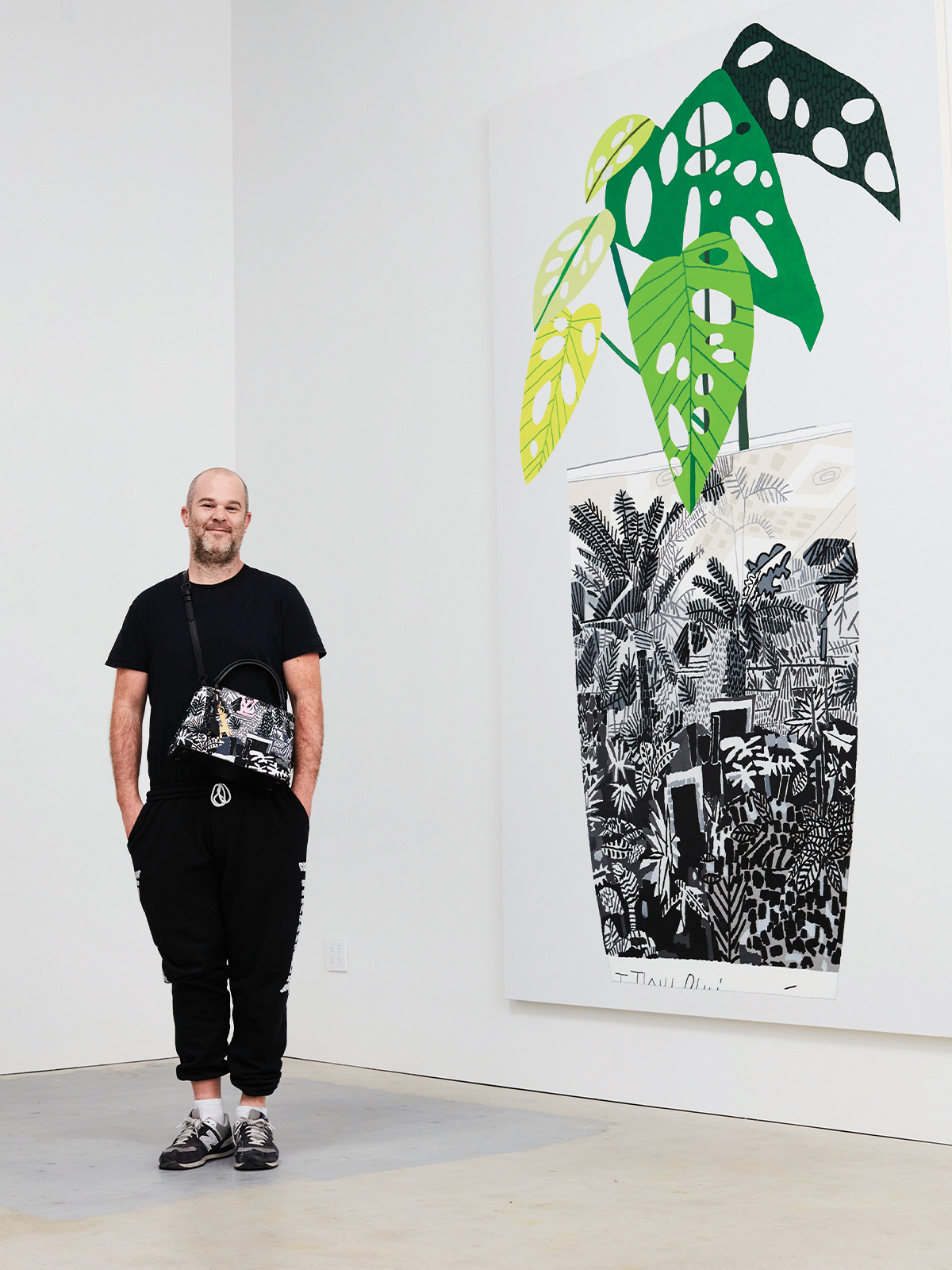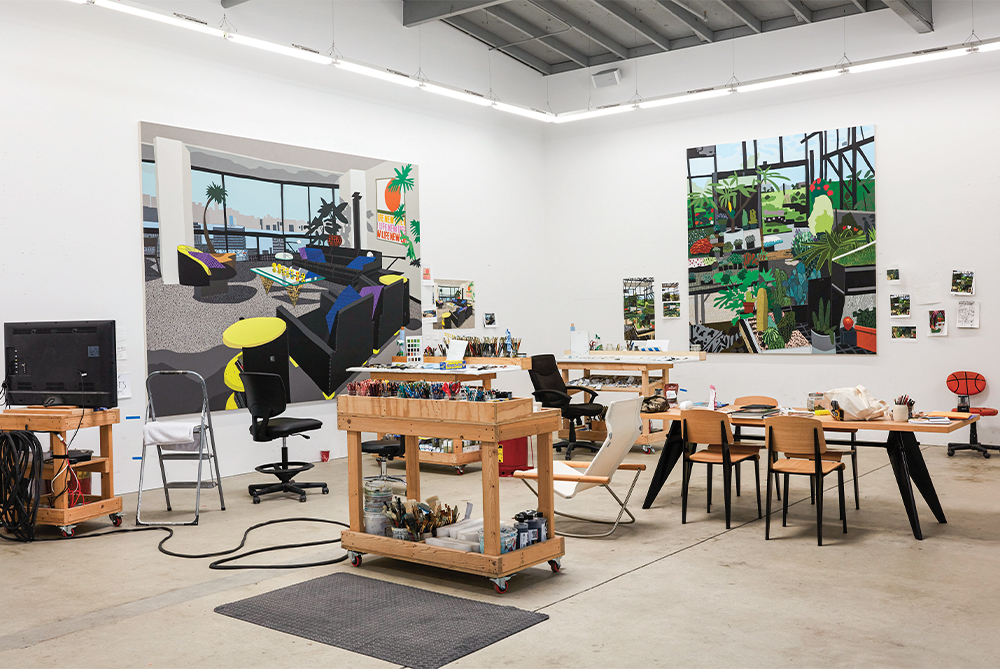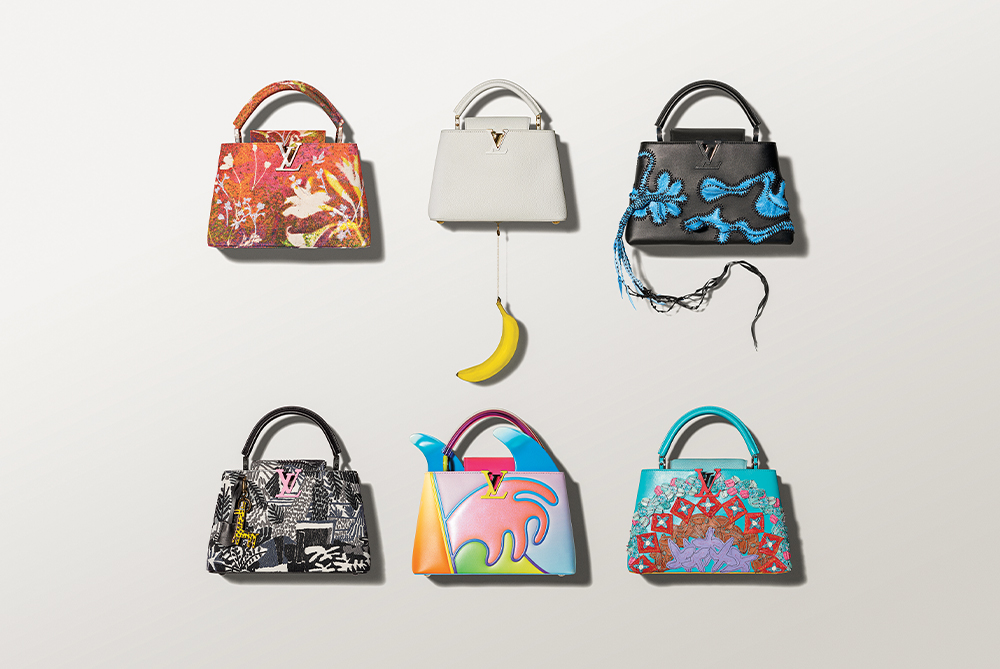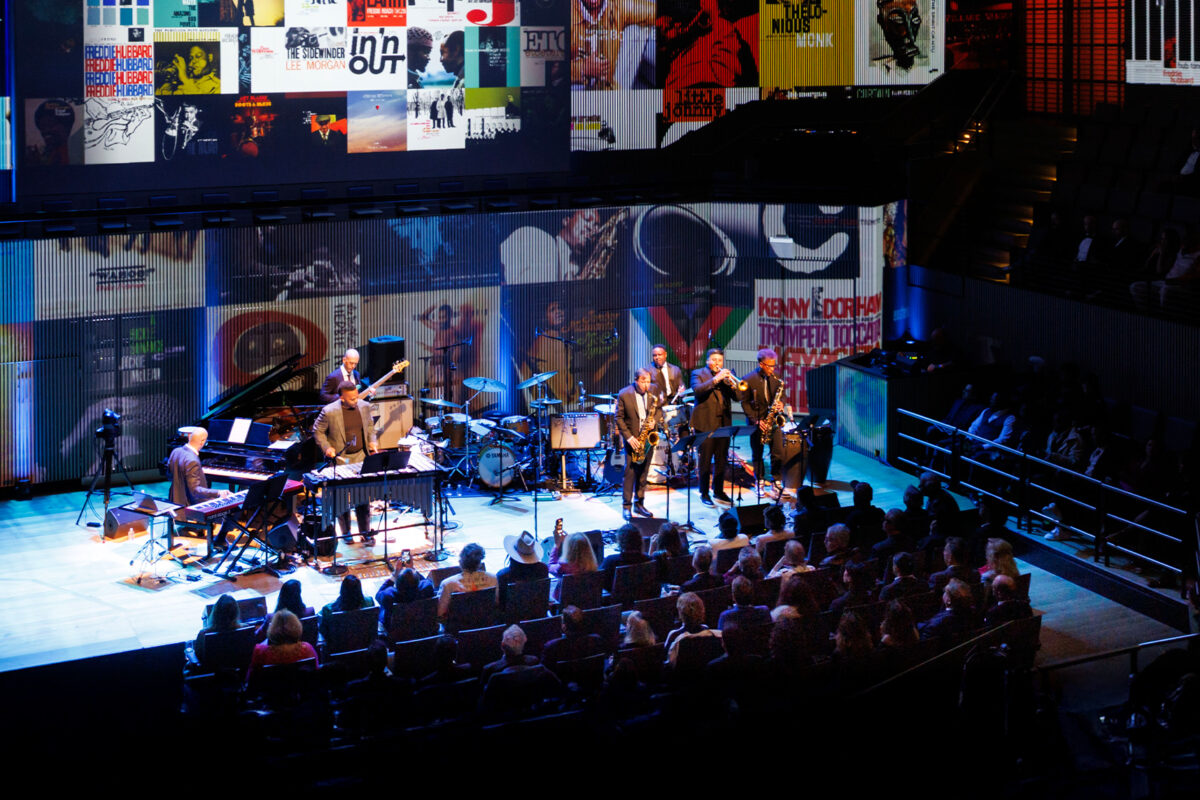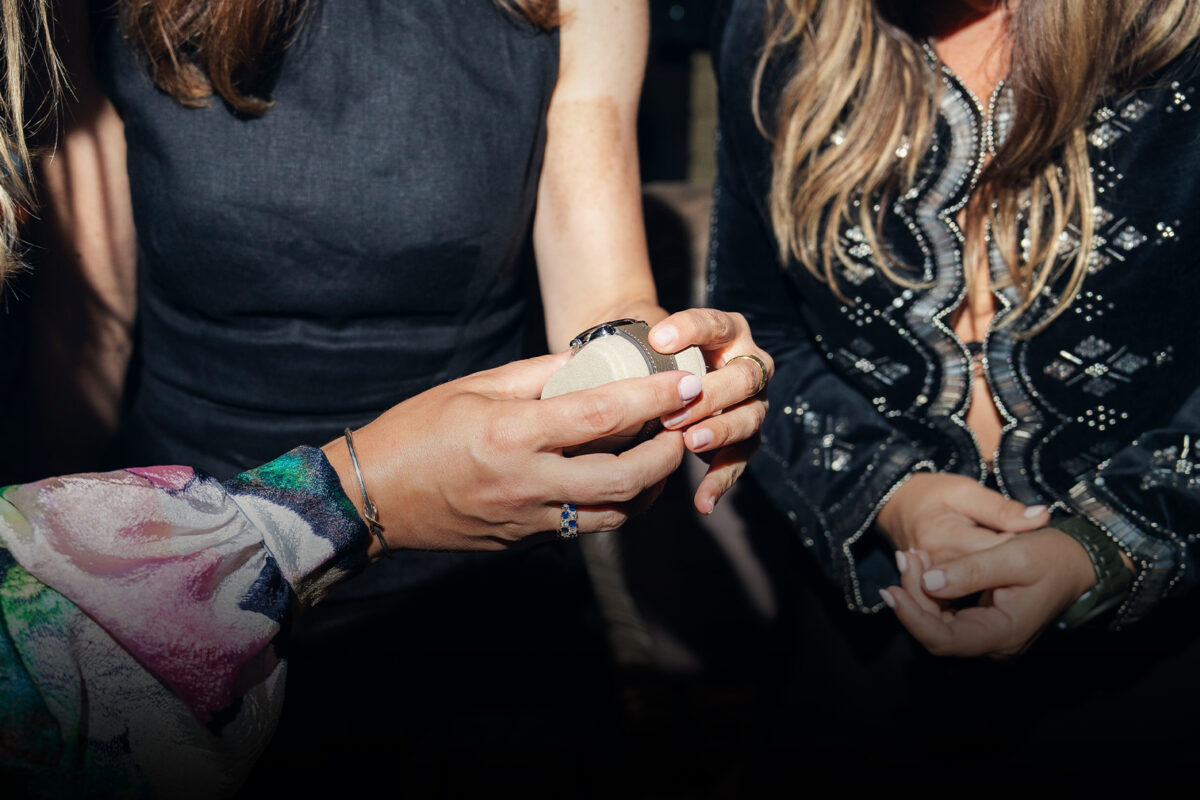Since the Boston-born artist moved to L.A. 16 years ago, his deeply personal canvases have become some of the most collectible on the West Coast. So why is he turning his paintbrush to handbags?
Words by PETER DAVIS
Artist Jonas Wood paints solely for himself. Brash, opinionated and outspoken, he refuses to listen to the advice of dealers or collectors. He also won’t accept commissions. “I say no 99.9 percent of the time,” he confirms, his deep voice sounding more surfer dude than the Boston-bred guy he is. “I have plenty of painting ideas. I don’t need to paint a picture of your family or your dog or a plant you like,” he says, sipping a LaCroix in his East Hollywood studio as reggae music plays in the background. Wood’s canvases are a complex, dizzying record of his day-to-day life: distorted, colorful and densely patterned interiors and still lifes; child-like pop art portraits of his close friends and his kids; lush, exotic plants and occasional nods to his favorite pastimes of poker and basketball. “Someone telling me what to paint seems so wrong,” he continues. “I always thought it was hard enough for me to paint my own shit.”
His bold, off-kilter realism has been compared to David Hockney, Alex Katz and Stuart Davis, and his work has skyrocketed in both price and popularity over the last decade. Advertising mogul Charles Saatchi, an early collector, bought a piece of Wood’s in 2009 for $45,000 that sold at Christie’s in London for over $600,000 in 2015. Last year, Wood’s 2008 painting Rosy’s Masks sold at auction for nearly $2 million. His pieces are in the collections of the Guggenheim Museum and MOMA in New York and L.A.’s MOCA. And at just 42, Wood recently had his first major solo museum show at the Dallas Museum of Art, on view until July 14.
Wood’s latest work, a collaboration with Louis Vuitton, ventures into the sartorial realm (LVMH’s Arnaults are among Wood’s many high-profile collectors). “I think that some artists look at fashion, but all of fashion looks at art for sure,” he says. For the project, Louis Vuitton gave Wood carte-blanche to create a limited-edition Capucines bag. Taking more than a year to complete, Wood’s unmistakable graphic imagery, shapes and motifs were printed on the bag’s leather, evoking Wood’s tropical landscape pot paintings. The printed leather was then embroidered, adding texture and depth and enforcing Wood’s affinity for outlining his images. (The 300 bags are priced at $8,600 each, still much more attainable than a canvas.) The collaboration is part of the fashion house’s “Louis Vuitton X” exhibit, a digitally infused experience showcasing over 180 items ranging from archival trunks to clothing to objects from 1854 to the present, topped off with ArtyCapucines, a collection of six artists’ (Wood, Sam Falls, Alex Israel, Nicholas Hlobo, Urs Fischer and Tschabalala Self) reinterpretations of the classic handbag.
“I came to L.A. because of the space. You need space to make art”
Growing up, Wood was surrounded by creativity as the son of an architect father and a mother who was the head of the theater department at the very progressive high school The Cambridge School of Weston, where he was also a student. He spent hours in the school’s theater with his mother, watching workmen build sets. His grandfather was a prominent art collector who sold a Francis Bacon painting at auction for a record price at the time. “He was a poor guy growing up, and then he became super rich and got a bunch of stuff,” Wood recalls of his grandfather, a pediatrician who made a small fortune in the postwar baby boom. “He started buying art. My grandmother had a really good eye. For 15 years they bought a lot of really cool shit … a Francis Bacon, a Motherwell, a Lichtenstein, Calder drawings, a Picasso drawing, a Frankenthaler. They had a Warhol Jackie O.” At first, Wood thought he would become a doctor like his grandfather. “I was going to be a psychologist or scientist. I went to college [Hobart and William Smith Colleges in Geneva, New York] and studied psychology and minored in art and right at the end I was like: ‘I don’t want to be a doctor. I want to be an artist.’” Wood imagined he might also become an art professor. “I thought I’d be so lucky to be a teacher and have a studio on campus and be able to make art,” he says. “So far [life has] exceeded what I would have been happy [with].”
A year after graduating from grad school for painting at the University of Washington in Seattle, he moved to Los Angeles in 2003 with his wife, ceramicist Shio Kusaka. “I came here because of the space,” he says. “You need space to make art. I met all these other artists; I was having my formative years growing up as a painter in Los Angeles. It coincided with my interest in still lifes and the crazy plants out here.” Wood got his first big break in 2006 with a solo show at Chinatown’s then red-hot gallery Black Dragon Society. He made enough money on the show to quit his day job. He also drew the attention of the Shane Campbell Gallery in Chicago and later the Anton Kern Gallery in New York City, each of which offered to show Wood’s work (both galleries, in addition to Gagosian and David Kordansky Gallery, represent the artist). Wood says the art scene in Los Angeles has evolved massively since he first arrived. “The museums are crazy on fire, interacting with the young artists in the community and abroad. It didn’t feel like that before. There’s way more artists here than Ed Ruscha and David Hockney. For a long time that’s maybe how myopically people saw it,” he says. “There are a million great artists here. The fact that Los Angeles has become an interesting city where people want to live — not just for art, but just in general — a city coming into a bigger existence. And at the same time, the art is becoming more prevalent and stronger.”
Wood, who is 6-foot-3 and has an unofficial uniform of baggy pants and a beanie, is an avid basketball fan (his favorite team: the Boston Celtics). A giant NBA basketball palanquin by Ghanaian artist Paa Joe commands a space in the studio. Wood mentions he has season tickets for the Clippers. He says, “There is no way I’m going to be able to go to 41 games plus the playoffs, but I try to go to a lot of them.” He makes time to play poker, too, and is part of a regular “art game” among industry figures, including painter Mark Grotjahn and gallerist Jeff Poe, that has been going on since 2008. The table is a $1,000 buy-in, but Wood won’t reveal the most he has won. “I just don’t want to say,” he replies cryptically, which brings to mind one of Wood’s most recognizable portraits: poker legend Doyle Brunson in a cowboy hat with stacks of cash and poker chips piled up in front of him.
“I never want it to feel like a job”
Wood and Kusaka share the studio in East Hollywood, and Kusaka’s ceramic pots often appear in Wood’s paintings. “We always joke that it would have been really bad if we were both painters,” he says. “But it makes a lot of sense that we do two different things, we’re totally super critical and great for each other’s practices and not judgmental. We don’t intentionally cross-pollinate our work or ask each other for permission to do shit.” He always works on multiple pieces at one time. “That’s how I like to set it up. I never want it to feel like a job. I want to just gravitate toward whatever I feel like is super positive that day. There’s a beginning, middle and an end to all these things, and my groove is somewhere between any of those, and I just want to lay in there and not feel stressed. I definitely paint in the postmodern/modern mold of trying to be a good painter and paint in these figurative painting molds.”
At Wood’s Dallas show, his 9-year-old daughter, Momo, appears in three paintings as well as the poster for the exhibit. Similar to how Wood grew up, his children [he also has a 7-year-old son named Kiki] are inundated with art making. “They love to paint and make things with my wife. We’ve asked them what they want to do and sometimes they say they want to be artists. … It’s so cool. They’re like our little friends,” he says with a proud grin. “They know what’s going on. They’ve got it in their genes.
Feature image: Wood stands in front of a giant basketball palanquin by Ghanaian artist PAA JOE. Photo by Peter Wetherell.
This story originally appeared in the Summer 2019 issue of C Magazine.

